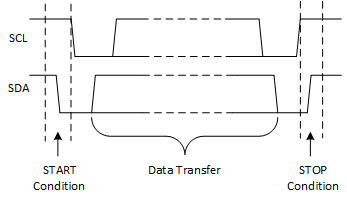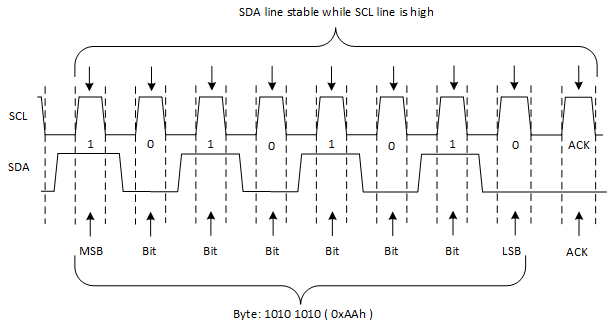JAJSM91 February 2022 TCA9537
PRODUCTION DATA
- 1 特長
- 2 アプリケーション
- 3 概要
- 4 Revision History
- 5 Pin Configuration and Functions
- 6 Specifications
- 7 Parameter Measurement Information
- 8 Detailed Description
- 9 Application Information Disclaimer
- 10Power Supply Recommendations
- 11Layout
- 12Device and Documentation Support
- 13Mechanical, Packaging, and Orderable Information
8.5.1 I2C Interface
The TCA9537 has a standard bidirectional I2C interface that is controlled by a controller device in order to be configured or read the status of this device. Each target on the I2C bus has a specific device address to differentiate between other target devices that are on the same I2C bus. Many target devices require configuration upon startup to set the behavior of the device. This is typically done when the controller accesses internal register maps of the target, which have unique register addresses. A device can have one or multiple registers where data is stored, written, or read. For more information see Understanding the I2C Bus application report, SLVA704.
The physical I2C interface consists of the serial clock (SCL) and serial data (SDA) lines. Both SDA and SCL lines must be connected to VCC through a pull-up resistor. The size of the pull-up resistor is determined by the amount of capacitance on the I2C lines. For further details, see I2C Pull-up Resistor Calculation application report, SLVA689. Data transfer may be initiated only when the bus is idle. A bus is considered idle if both SDA and SCL lines are high after a STOP condition. See Interface Definition.
Figure 8-3 and Figure 8-4 show the general procedure for a controller to access a target device:
- If a controller wants to send
data to a target:
- Controller-transmitter sends a START condition and addresses the target-receiver.
- Controller-transmitter sends data to target-receiver.
- Controller-transmitter terminates the transfer with a STOP condition.
- If a controller wants to receive
or read data from a target:
- Controller-receiver sends a START condition and addresses the target-transmitter.
- Controller-receiver sends the requested register to read to target-transmitter.
- Controller-receiver receives data from the target-transmitter.
- Controller-receiver terminates the transfer with a STOP condition.
 Figure 8-3 Definition of Start and Stop Conditions
Figure 8-3 Definition of Start and Stop Conditions Figure 8-4 Bit
Transfer
Figure 8-4 Bit
Transfer